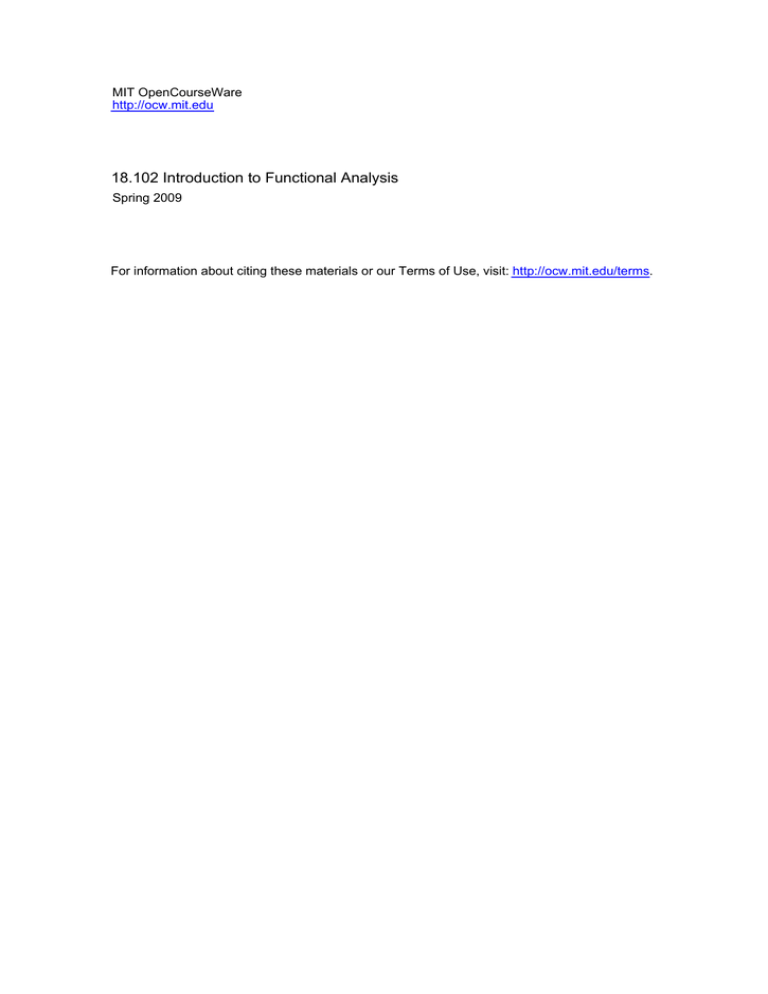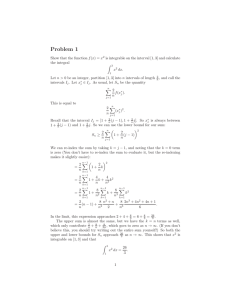18.102 Introduction to Functional Analysis
advertisement

MIT OpenCourseWare
http://ocw.mit.edu
18.102 Introduction to Functional Analysis
Spring 2009
For information about citing these materials or our Terms of Use, visit: http://ocw.mit.edu/terms.
18
LECTURE NOTES FOR 18.102, SPRING 2009
Lecture 4. Thursday, 12 Feb
I talked about step functions, then the covering lemmas which are the basis of
the definition of Lebesgue measure – which we will do after the integral – then
properties of monotone sequences of step functions.
To be definite, but brief, by an interval we will mean [a, b) – an interval closed
on the left and open on the right – at least for a little while. This is just so the
length of the interval, b − a, only vanishes when the interval is empty (not true for
closed intervals of course) and also so that we can decompose an interval, in this
sense, into two disjoint intervals by choosing any interior point:
[a, b) = [a, t) ∪ [t, b), a < t < b.
(4.1)
Now, by a step function
f : R −→ C
(4.2)
(although often we will restrict to functions with real values) we mean a function
which vanishes outside a finite union of disjoint ‘intervals’ and is constant on each
of them. Thus f (R) is finite – the function only takes finitely many values – and
(4.3)
f −1 (c) is a finite union of disjoint intervals, c �= 0.
It is also often convenient to write a step function as a sum
(4.4)
f=
N
�
ci χ[ai ,bi )
i=1
of multiples of the characteristic functions of our intervals. Note that such a ‘pre­
sentation’ is not unique but can be made so by demanding that the intervals be
disjoint and ‘maximal’ – so f is does not take the same value on two intervals with
a common endpoint.
Now, a constant multiple of a step function is a step function and so is the sum
of two step functions – clearly the range is finite. Really this reduces to checking
that the difference [a, b) \ [a� , b� ) and the union of two intervals is always a union of
intervals. The absolute value of a step function is also a step function.
A similar argument shows that the integral, defined by
�
�
(4.5)
f=
ci (bi − ai )
R
i
from (4.4) is independent of the ‘presentation’ used to define it. It is of course equal
to the Riemann integral which is one way of seeing that it is well-defined (but of
course the result is much more elementary).
Proposition 1. The step functions on R in the sense defined above form a normed
space with the L1 norm
�
(4.6)
�f �L1 =
|f |.
R
So, we will complete this space instead of the continuous functions – it is both
more standard and a little easier. The fact that we can directly construct a ‘con­
crete’ completion is due to Mikusiński. Already at this stage we can define a
Lebesgue integrable function, however we need to do some work to flesh out the
definition.
LECTURE NOTES FOR 18.102, SPRING 2009
19
Definition 3. A function g : R −→ C is Lebesgue integrable if there exists an
absolutely summable sequence of step functions fn , i.e. satisfying
��
(4.7)
|fn | < ∞
n
such that
(4.8)
f (x) =
�
fn (x) ∀ x ∈ R such that
n
�
|fn (x)| < ∞.
n
So, the definition is a little convoluted – there must exist a sequence of step
functions the sum the integrals of the absolute values of which converges and such
that the sum itself converges to the function but only at the points of absolute
converge of the (pointwise) series. Tricky, but one can get used to it – and ultimately
simplify it. The main attraction of this definition is that it is self-contained and in
principle ‘everything’ can be deduced from it.
Now, the first thing we need is the covering lemma – basically some properties of
countable collections of our ‘intervals’ such as will arise when we look at a sequence,
or series, of step functions. I leave it to you to devise careful proofs of the following
two facts.
Lemma 1. If Ci = [ai , bi ), i = 1, . . . , N, is a finite collection of intervals then
(4.9)
Ci ⊂ [a, b) ∀ i and Ci ∩ Cj = ∅ ∀ i =
� j =⇒
N
�
(bi − ai ) ≤ (b − a).
i=1
On the other hand
(4.10)
[a, b) ⊂
N
Ci =⇒
i=1
N
�
(bi − ai ) ≥ (b − a).
i=1
You can prove this by inserting division points etc.
Now, what we want is the same thing for a countable collection of intervals.
Proposition 2. If Ci = [ai , bi ), i ∈ N, is a countable collection of intervals then
(4.11)
Ci ⊂ [a, b) ∀ i and Ci ∩ Cj = ∅ ∀ i =
� j =⇒
∞
�
(bi − ai ) ≤ (b − a)
i=1
or
(4.12)
[a, b) ⊂
N
i=1
Ci =⇒
∞
�
(bi − ai ) ≥ (b − a).
i=1
Proof. You might think these are completely obvious, and the first is – the hypoth­
esis (4.9) holds for any finite subcollection and hence the finite sum is always less
than the fixed number b − a and hence so is the infinite sum – which therefore
converges.
On the other hand (4.12) is not quite so obvious since it depends on Heine-Borel.
To be able to apply (4.10) choose δ > 0. Now extend each interval by replacing the
lower limit by ai − 2−i δ and consider the open intervals which therefore have the
property
(4.13)
[a, b − δ] ⊂ [a, b) ⊂ (ai − 2−i δ, bi ).
i
20
LECTURE NOTES FOR 18.102, SPRING 2009
Now, by Heine-Borel – the compactness of closed bounded intervals – a finite subcol­
lection of these open intervals covers [a, b − δ) so (4.10) does apply to the semi-open
intervals and shows that for some finite N (hence including the finite subcollection)
(4.14)
N
∞
�
�
(bi − ai ) − 2−i δ ≥ b − a − δ =⇒
(bi − ai ) ≥ b − a − 2δ
i=1
i=1
where the sum here might be infinite, but then it is all the more true. The fact
that this is true for all δ > 0 now proves (4.12).
�
Welcome to measure theory.
Okay, now the basis result on which most of the properties of integrable functions
hinge is the following monotonicity lemma.
Lemma 2. Let fn be a sequence of step functions which decreases monotonically
to 0
(4.15)
fn (x) ↓ 0 ∀ x ∈ R,
then
�
(4.16)
lim
fn = 0.
Note that ‘decreases’ here means that fn (x) is, for each x, a non-increasing
sequence which has limit 0. Of course this means that all the fn are non-negative.
Moreover the first one vanishes outside some interval [a, b) hence so do all of them.
The crucial thing about this lemma is that we get the vanishing of the limit of the
sequence of integrals without having to assume uniformity of the limit.
Proof. Going back to the definition
� of the integral of step functions, clearly fn (x) ≥
fn+1 (x) for all x implies that fn is a decreasing (meaning non-increasing) se­
quence. So there are only two possibilities, it converges to 0, as we claim, or it
converges
to some positive value. This means that there is some δ > such that
�
fn > δ for all n, so we just need to show that this is not so.
Given an � > 0 consider the sets
(4.17)
Sj = {x ∈ [a, b); fj (x) ≤ �}.
(Here [a, b) is an interval outside which f1 vanishes and hence all the fn vanish
outside it). Each of the Sj is a finite union of intervals. Moreover
(4.18)
Sj = [a, b)
j
since fn (x) → 0 for each x. In fact the Sj increase with j and if we set B1 = S1
and
(4.19)
Bj = Sj+1 \ Sj
then the Bj are all disjoint, each consists of finitely many intervals and
(4.20)
Bj = [a, b).
Thus, both halves of Proposition 2 apply to the intervals forming the Bj . If we let
l(Bj ) be the length of Bj – the sum of the lengths of the finitely many intervals of
LECTURE NOTES FOR 18.102, SPRING 2009
21
which it is composed – then
�
(4.21)
l(Bj ) = b − a.
j
Now, let A be such that f1 (x) ≤ A – and hence it is an upper bound for all the
fn ’s. We can choose N so large that
�
(4.22)
l(Bj ) < �.
j≥N
Dividing the integral for fk , k ≥ N, into the part over SN and the rest we see that
�
(4.23)
fk ≤ (b − a)� + �A.
The first estimate comes for the fact the fact that fk ≤ � on SN , and the second
that the total lengths of the remaining intervals is no more than � (and the function
is no bigger than A.)
Thus the integral is eventually small!
�
We can make this result look stronger as follows.
Proposition 3. Let gn be a sequence of real-valued step functions which is nondecreasing and such that
(4.24)
lim gn (x) ∈ [0, ∞] ∀ x ∈ R
n→∞
then
�
(4.25)
lim
n→∞
gn ∈ [0, ∞].
I have written out [0, ∞] on the right here to make sure that it is clear that we only
demand that the non-decreasing sequence gn (x) ‘becomes 0 or positive’ in the limit
– including the possibility that it ‘converges’ to +∞ and then the same is true of
the sequence of integrals.
Proof. Consider the functions
(4.26)
fn (x) = max(0, −gn (x)) ∀ x ∈ R.
This is a sequence of non-negative step functions which decreases to 0 at each point
and
�
�
(4.27)
gn ≥ − fn .
Thus, as claimed, the result follows from the lemma.
�
Next time we will use this to show that the definition of a Lebesgue integrable
function above makes some sense. In particular we will show that the integral is
well-defined!


